We’ve all heard of hamsters and fish as class pets, but some schools are taking things a step further and bringing dogs into the classroom. Although some programs are met with skepticism, it’s overwhelmingly clear that schools are doing well with this strategy, whether they are for behavior issues, disability service, or even reading programs. Read on, and you’ll find out about new and inspiring ways that dogs are being put to work in education.
-
Putting an end to bullying
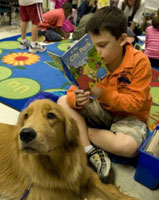 Bullying is a problem in so many classrooms, with children anxious about school for fear of taunting and abuse. But in some schools, dogs are making a difference in the fight against bullies. Through programs like Kansas City’s No More Bullies, volunteers and dogs visit schools to teach kids about compassion and fairness. Developers of the program report that kids can identify with animals, and with empathy for the dog, can better understand how classmates may feel. Jo Dean Hearn of No More Bullies shares, “it’s easy for them to transition when we ask them to consider how an animal feels (if ill treated) to how the kid sitting near them feels (if poorly treated).” The programs sure seem to work, with a long waiting list for No More Bullies. In a study of a similar program, Healing Species, it was found that violent behavior in participating students declined by 55%, and general aggression went down 62%.
Bullying is a problem in so many classrooms, with children anxious about school for fear of taunting and abuse. But in some schools, dogs are making a difference in the fight against bullies. Through programs like Kansas City’s No More Bullies, volunteers and dogs visit schools to teach kids about compassion and fairness. Developers of the program report that kids can identify with animals, and with empathy for the dog, can better understand how classmates may feel. Jo Dean Hearn of No More Bullies shares, “it’s easy for them to transition when we ask them to consider how an animal feels (if ill treated) to how the kid sitting near them feels (if poorly treated).” The programs sure seem to work, with a long waiting list for No More Bullies. In a study of a similar program, Healing Species, it was found that violent behavior in participating students declined by 55%, and general aggression went down 62%. -
Autism service dogs
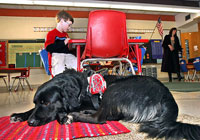 Children with autism typically have trouble with concentration and interaction at school and beyond. With the help of a service dog, students may be able to increase their abilities and do better in the classroom. First grader Jake Barry puts his service dog Quincy to work at school, helping him with his concentration and socialization, as well as helping him keep calm. Jake’s mother Angela indicates that he’s done well with the dog, increasing his focus and ability to sit down and work for longer periods. Additionally, Barry reports, “he’s calmer, more accepting and much more on target,” all things that help Jake do better in school. Quincy also helps Jake slow down and be happier, because “he has to slow down and stay at Quincy’s pace,” so Jake is less anxious and less rigid; when he gets upset, he’s less likely to have a tantrum.
Children with autism typically have trouble with concentration and interaction at school and beyond. With the help of a service dog, students may be able to increase their abilities and do better in the classroom. First grader Jake Barry puts his service dog Quincy to work at school, helping him with his concentration and socialization, as well as helping him keep calm. Jake’s mother Angela indicates that he’s done well with the dog, increasing his focus and ability to sit down and work for longer periods. Additionally, Barry reports, “he’s calmer, more accepting and much more on target,” all things that help Jake do better in school. Quincy also helps Jake slow down and be happier, because “he has to slow down and stay at Quincy’s pace,” so Jake is less anxious and less rigid; when he gets upset, he’s less likely to have a tantrum. -
Solving truancy problems
 At Tonaganixie Middle School in Kansas, principal Steve Woolf found himself facing Mandy, a special needs student with an extreme case of truancy. When Woolf met Mandy, she had been absent for 40 days of the school year, and was in truancy court. Faced with the problem of figuring out how to keep Mandy in school, Woolf enlisted the help of River, a service dog. Woolf got Mandy back in school with the promise of a surprise, and River was it, telling her that “if she didn’t come to school to care for him, he wouldn’t get walks, water or love.” With the incentive of caring for River, Mandy came to school almost every day for the rest of the year, only missing two days.
At Tonaganixie Middle School in Kansas, principal Steve Woolf found himself facing Mandy, a special needs student with an extreme case of truancy. When Woolf met Mandy, she had been absent for 40 days of the school year, and was in truancy court. Faced with the problem of figuring out how to keep Mandy in school, Woolf enlisted the help of River, a service dog. Woolf got Mandy back in school with the promise of a surprise, and River was it, telling her that “if she didn’t come to school to care for him, he wouldn’t get walks, water or love.” With the incentive of caring for River, Mandy came to school almost every day for the rest of the year, only missing two days. -
Managing behavior problems
 Behavior problems are serious in school, and as many as one in 10 children suffers from a behavior disorder bad enough to interfere with learning and development. Some schools are using dogs to improve behavior problems, promoting positive behavior in students. In a controlled study, students were found to have fewer disciplinary referrals than classrooms without animals. Students’ behavior improved toward teachers, and students also showed more confidence and responsibility. Additionally, parents reported that children seemed more interested in school as a result of having the animals around.
Behavior problems are serious in school, and as many as one in 10 children suffers from a behavior disorder bad enough to interfere with learning and development. Some schools are using dogs to improve behavior problems, promoting positive behavior in students. In a controlled study, students were found to have fewer disciplinary referrals than classrooms without animals. Students’ behavior improved toward teachers, and students also showed more confidence and responsibility. Additionally, parents reported that children seemed more interested in school as a result of having the animals around. -
Promoting reading
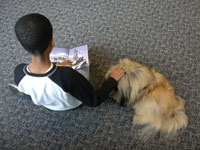 It might seem a bit silly to read to a dog, but canine reading programs are doing wonders for young students. Children who might be embarrassed to read aloud to the class or even adults are likely to be less scared to read to a dog. In Childhood Education, Mary Renck Jalongo points out, “It might be less stressful for a child to read aloud to a dog than to a teacher or a peer. After all, a dog won’t judge or correct you.” With the Reading Education Assistance Dogs program, also known as READ, dogs are used to encourage struggling readers to practice reading aloud. With the presence of a “calm and well-trained dog,” students find social support and peer interaction. On top of spending time with a favorite therapy dog, students are offered incentives, including “pawtographed” books. After reading 10 books, students earn a book stamped with the paw print of their favorite therapy dog. In other programs reading to dogs is the incentive, allowing students to read to therapy dogs if they met their literacy goals.
It might seem a bit silly to read to a dog, but canine reading programs are doing wonders for young students. Children who might be embarrassed to read aloud to the class or even adults are likely to be less scared to read to a dog. In Childhood Education, Mary Renck Jalongo points out, “It might be less stressful for a child to read aloud to a dog than to a teacher or a peer. After all, a dog won’t judge or correct you.” With the Reading Education Assistance Dogs program, also known as READ, dogs are used to encourage struggling readers to practice reading aloud. With the presence of a “calm and well-trained dog,” students find social support and peer interaction. On top of spending time with a favorite therapy dog, students are offered incentives, including “pawtographed” books. After reading 10 books, students earn a book stamped with the paw print of their favorite therapy dog. In other programs reading to dogs is the incentive, allowing students to read to therapy dogs if they met their literacy goals. -
Social development
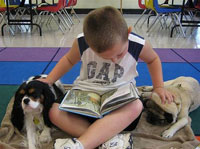 Dogs in school offer an opportunity for improving social development at nearly every stage, from elementary age children to teens. They are especially useful for teaching students social skills and responsibility. Specifically, schools are using dogs to help tweens build self esteem, learn about positive and negative reinforcement, responsibility, and boundaries. Older kids and teens use dogs to help communicate, teach kindness, and empower students through dog training programs.
Dogs in school offer an opportunity for improving social development at nearly every stage, from elementary age children to teens. They are especially useful for teaching students social skills and responsibility. Specifically, schools are using dogs to help tweens build self esteem, learn about positive and negative reinforcement, responsibility, and boundaries. Older kids and teens use dogs to help communicate, teach kindness, and empower students through dog training programs. -
Researching pine tree disease
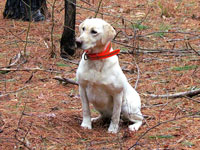 Dogs have been used to detect drugs for years, but Auburn University is using the detection skills of dogs for a different purpose: fighting pine tree disease. The school has created an EcoDogs program, using dogs to detect deadly fungus in pine tree roots that has led to “Southern pine decline,” which affects more than a million acres in the southeastern US. The detector dogs are being trained to snuff out the fungi that are attacking tree roots. The dogs offer a particular advantage as they are noninvasive, do not disturb the beetles, or spread the fungus. Before using EcoDogs, land owners and researchers had to dig up roots to inspect the trees, causing them to release stress chemicals that can attract more beetles. Researchers believe that using dogs to stop pine tree disease is a very positive step to advancing the management of pine plantations and stopping the disease.
Dogs have been used to detect drugs for years, but Auburn University is using the detection skills of dogs for a different purpose: fighting pine tree disease. The school has created an EcoDogs program, using dogs to detect deadly fungus in pine tree roots that has led to “Southern pine decline,” which affects more than a million acres in the southeastern US. The detector dogs are being trained to snuff out the fungi that are attacking tree roots. The dogs offer a particular advantage as they are noninvasive, do not disturb the beetles, or spread the fungus. Before using EcoDogs, land owners and researchers had to dig up roots to inspect the trees, causing them to release stress chemicals that can attract more beetles. Researchers believe that using dogs to stop pine tree disease is a very positive step to advancing the management of pine plantations and stopping the disease. -
Teaching responsibility
 With a dog in the classroom, students have the opportunity to learn how to care for the animal. This includes walking, grooming, and feeding the dog, chores which can be distributed among the class. Trainers report that involving students in the daily care of classroom dogs is a positive experience, promoting their own daily care, like brushing their teeth at home. The students also learn about responsibility, caring, and sharing when helping each other take care of a dog at school.
With a dog in the classroom, students have the opportunity to learn how to care for the animal. This includes walking, grooming, and feeding the dog, chores which can be distributed among the class. Trainers report that involving students in the daily care of classroom dogs is a positive experience, promoting their own daily care, like brushing their teeth at home. The students also learn about responsibility, caring, and sharing when helping each other take care of a dog at school. -
Allergy alerts
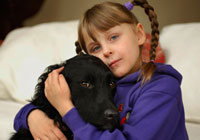 Just as dogs can be used to detect drugs, bombs, and even pine tree fungus, they can also be used to detect allergens, which is especially helpful for students with life threatening allergies, especially peanut allergies. Although schools often enact policies designed to help students avoid the allergens that can cause severe problems for them, it’s not always possible, and mistakes can happen. With the help of allergy alert dogs, students with life threatening allergies can be alerted to the presence of substances that may harm them. For students with severe allergies, these dogs can be life saving.
Just as dogs can be used to detect drugs, bombs, and even pine tree fungus, they can also be used to detect allergens, which is especially helpful for students with life threatening allergies, especially peanut allergies. Although schools often enact policies designed to help students avoid the allergens that can cause severe problems for them, it’s not always possible, and mistakes can happen. With the help of allergy alert dogs, students with life threatening allergies can be alerted to the presence of substances that may harm them. For students with severe allergies, these dogs can be life saving.
No comments:
Post a Comment